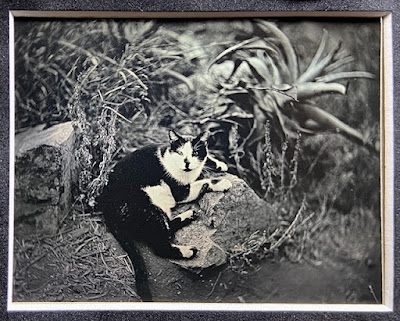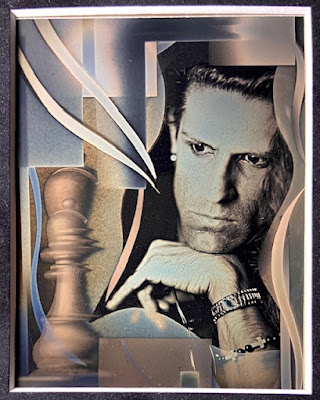Resolving power of a daguerreotype may never be surpassed by conventional means, and the almost holographically iridescent quality provided by light striking their surfaces at different angles makes this technique stand in the category apart from all others. A daguerreotype is a true photographic object; it has weight and presence, each image is entirely one of a kind. Holding a well made daguerreotype is a unique experience, be it a modern image or one created 160 years ago. Using modern materials, and having the accumulated knowledge of the past to aid in their preservation, daguerreotypes I craft today can be safely assumed to last for a number of centuries.
At my studio in San Diego, I am pleased to offer workshops in both traditional and Becquerel methods of making daguerreotype images. Workshops are scheduled on one by one basis so feel free to reach out.
Below are a few select examples of my daguerreotype work and a short video with brief explanation of the process. Enjoy!
2021 Peace - 4x5in - Morse Code Using Sun
Below are a few select examples of my daguerreotype work and a short video with brief explanation of the process. Enjoy!
Stills, Views, and Experimental Methods
In this section we have a selection of traditional mercury daguerreotypes of all styles. I've always detested mundaneness, and settling for a specific style was never an option in my artistic pursuits. Some of the images below are as traditional as it gets, and I love their raw simplicity and historic gravitas. One should never say concretely that they have mastered daguerreotype, as the chemical gremlins are always waiting to throw a monkey wrench into the practice of even those who have worked with this process a lifetime, which I've recently witnessed personally. However, once I got proficient enough, I wanted to explore what else lay hidden underneath the antique and dusty surface of daguerreotypy. Some quite experimental works are thus included below as well. My search for new horizons continues, and I look forward to adding works to this page as progress arises.
Some plates below are marked as sold, some are marked NFS (not for sale) or NFSA (not for sale alone, so purchasable as a series only). The rest are waiting for an appreciative patron, and quite a few more available plates could be shown by request.
2018 Oak, 8x10in
2019 Coronado Bridge, 3-lens Antorama, 3 4x5in plates (sold)
2019 Botanical Building, Balboa Park San Diego, 4-lens Antorama, 7 4x5in plates (sold)
2019 What Remains - 4x5in (sold)
2019 Hunter - Chimacabres Series - 4x5in (NFSA)
2019 Fortune Teller - Chimacabres Series - 4x5in (NFSA)
2019 Eye - 4x5in
2020 From Daguerrean Dream Series - 4x5in (NFSA)
2021 From Daguerrean Dream Series - 4x5in (NFSA)
2019 From Daguerrean Dream Series - 4x5in (NFSA)
2019 From Daguerrean Dream Series - 4x5in (NFSA)
2018 Redwoods - 4x5in (NFS)
2019 Old Mission Dam - 4x5in (sold)
2019 Masks - 4x5in(sold)
2019 Blue Day - 4x5in (sold)
2024 April 8th Solar Eclipse Totality, Alton MO - 4x5in
2021 Joy - 4x5in - Morse Code Using Sun
2021 Life - 4x5in - Morse Code Using Sun
2021 Peace - 4x5in - Morse Code Using Sun
2018 Luthier - 1/4 plate
2018 Luthier Tools 1 - 1/4 plate
2018 Luthier Tools 2 - 1/4 plate
2018 Luthier Tools 3 - 1/4 plate
2018 For Irving, 1/4 plate(sold)
2018 Sun and Clouds, 1/6 plate(sold)
2018 Redwood, 4x5in (sold)
2020 Banyan Tree - 4x5in (sold)
2021 Queen Sacrifice - From Chess Series 4x5in (NFSA)
2021 Lines - From Chess Series - 8x10in (NFSA)
2021 Bishop Pair - From Chess Series - 4x5in (NFSA)
2021 Death Valley Charcoal Kilns - 4x5in
2020 Three Giant Redwoods - 4x5in
2020 Natural Rafting on Redwoods - 4x5in
2020 Water Tower -Triple Exposure - 4x5in (sold)
2018 Grand Titons at Sunset, 4x5in (sold)
2018 Ostrich Egg, 1/4 plate
2017 Homage to Irving Penn #1, 4x5 (sold)
2017 Homage to Irving Penn #2, 4x5
2017 Homage to Irving Penn #3, 4x5
2017 Homage to Irving Penn #4, 4x5in (sold)
2017 Balboa Park 1/6 plate (sold)
2017 Still Life with Equipment, Hand Tinted 4x5in (sold)
2018 View East down Howard St. from Park Blvd, 1/6 plate (sold)
2017 Still Life with Pomegranate, 1/4plate (sold)
Portrait Work
Persons wishing to possess daguerreotype likenesses of themselves or of their significant others, are encouraged to get in touch via email listed on contact page. Images made in studio or on location. Multitude of finishing options available upon request.
Prices reasonable, satisfaction guaranteed.
Becquerel Method:
In 1840, a method of developing daguerreotype plates without use of mercury was discovered by Edmund Becquerel. With this method, the image is developed via the acton of actinic light. Becquerel daguerreotypes have a number of limiting factors that make it much harder to achieve truly stunning results, but the ease of making them somewhat compensates for what they lack in appearance.
Becquerel maybe be a good way to get started in the process, as a lot of the steps are the same with both methods, so while saving up for the rest of equipment needed for mercury work, one can really take time and hone in their polishing skills and train the eye for what they are looking at while fuming the plate. Plus there's a lot less dangerous chemistry involved, so in reality a lot of current daguerreotype makers worldwide are using Bequerel development full time, and not bothering with mercury and bromine. Below are a few samples of my Becquerel plates and anyone wishing to learn this can schedule a workshop by sending a message to email listed on contact page.
The Making of a Daguerreotype, traditional method.


























































Phenomenal.... I've always wanted to see the process and now I have. Is the camera used an original Daguerreotype camera?
ReplyDeleteThanks for the comment!
DeleteWhile I do use modern as well as 10th century lenses, I use modern large format cameras most of the time, which are basically the same design as in 1850s, but with a lot of added advantages. For me it’s not about replicating the look of plates of the days of yore, I’d rather use all tools available currently in order to best taylor this medium to my own artistic vision.
I've been working on making a daguerreotype for months now. It has required designing all manner of devices: fuming boxes for mercury, iodine and bromine. The most difficult process is the polishing, but I"m also having trouble getting the plate to sensitize evenly. How do I find out about a workshop? I live in New York.
ReplyDeleteHi! First off, congrats on even thinking about tackling this process, that a step that most folks will not undertake. If you email me (look at the contact page for direct email) I’d be happy to help you to the extent hat I can. Secondly, you’re in great luck as you are in NY. There’s a fellah named Jerry Spagnoli who resides in the Big Apple who is arguably the very best at this process at this moment. If you want a workshop, then he’s the man to ask (if you don’t want to travel to CA that is). Key is be said here and not though that you will find NO two current daguerreotype makers who have the exact same polishing technique. Meaning that you may benefit strongly from a workshop from this guy of the other; but in the end it will be your perseverance; ingenuity, and commitment that will lead you to any form of success.
Delete